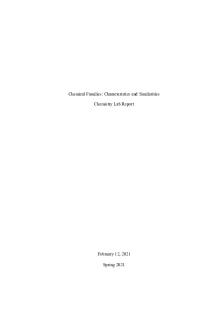Chapter 11- Families and Society PDF

| Title | Chapter 11- Families and Society |
|---|---|
| Author | RaJanir Horton |
| Course | Introduction To Sociology |
| Institution | Kent State University |
| Pages | 3 |
| File Size | 91.9 KB |
| File Type | |
| Total Downloads | 75 |
| Total Views | 143 |
Summary
taught by Professor Owens...
Description
Chapter 11: Families and Society
Family o two or more individuals who live together and have a legally or normatively recognized relationship May be based on marriage, birth, adoption o Reproduction of a community and citizenry o Socialization and transition of culture o Care of the young and old o Contribute to the economy as consumers o Allocation of social roles o Extended families: one or more parents, children, other kin, several generations, living in the same household Eastern/southern Europe, Africa, Asia, Central/Latin America In the United States, more common in lower income, rural immigrant, minority families o Nuclear families: parents living with biological children, apart from other kin Northern/Western Europe, Canada, United states, Australia
Marriage o legal or culturally normative relationship between two individuals Functions: economic cooperation, emotion intimacy, sexual relations Legitimatized by law, religion, cultural norms o Endogamous marriage: limited to partners who are members of the same social group o Monogamy: person may have only one spouse at a time o Polygamy: person may have more than one marital partner at a time Polygyny: man may have multiple wives Polyandry: women may have multiple husbands o Serial monogamy: practice of having more than one wife or husband, but only at a time; characterizes patterns in the United States
Parson’s Sex roles in U.S kinship o Family is a “factory of personalities” Women socialized into expressive roles (e.g., emotion work) Men socialized into instrumental roles (e.g., task work) Complementary roles are positively functional Ensure cooperation rather than conflict Status of family derived from male’s position
o Parsons worried that social change in roles could have negative consequences Fundamentally changes economic structure with dual income Feminist/conflict theories o Emerged from women’s movement during the 1970s o Sexual division of labor: dividing production by gender (men produce, and women reproduce) Designating different spheres of activity, the “private” to women and “public to men Gives males privileged access to money, status, independence, opportunity His and her marriages o His marriage: defines himself as burdened, constrained, while experiencing authority, independence, and right to sexual, domestic, and emotion services of life o Her marriage: defines herself as fulfilled through marriage, while experiences dependence and subjugation to husband o Stress indicators Married women, unmarried men score highest Unmarried women, married men score lowest The family evolves o Pre-industrial/agricultural: families were social and economic units Multiple generations, children valued for production, enduring marriages o Industrialization/urbanization: families shrink as children become a cost rather than a wage-earning benefit o Nuclear family model: mother-as-homemaker and father-as-breadwinner evolved among middle class families in the 19th century Less common among working-class families Post-World War II era, suburbanization, economic growth, consumption, “baby boom” Black families segregated into urban areas, barred from subsidized mortgages (recall redlining) The female mystique: women’s discontent born of exclusion/marginalization in the workplace, feelings of unfulfillment Primarily middle-class, white women Social class and Childbearing o Concerted cultivation: middle-class; negotiation, discussion, questioning authority, cultivation of talents through activities, autonomy Sense of enlightenment, higher skilled careers, negotiate with people in authority o Accomplishment of natural growth: working-class; directives, obedience, meet basic needs, unstructured play, independence
Lower skilled jobs, respect for authority and obedience Student debt and Family formation o Students graduating with higher levels of debt than ever before o 14% responded that loans delayed marriage o 20% responded that they delayed having children because of loans o Among low income Pell-grant recipients: 19% indicted they delayed marriage 24% delayed childbearing due to debt Domestic violence o Physical or sexual abuse committed by one family member against another Adults towards children, spousal, among siblings, adult children against elderly parents 1/3 women, 1/4 men have experienced IPV (intimate partner violence) Cyclical: about 30% may become abusers 11% of elderly experience abuse/neglect o Leading cause of homelessness nationally, especially for women...
Similar Free PDFs

Chapter 11- Families and Society
- 3 Pages

Families and Households 11
- 1 Pages

Aging and Society Chapter 8
- 7 Pages

Families and Households
- 36 Pages

Families Households
- 19 Pages

Chapter 11 and 12
- 3 Pages
Popular Institutions
- Tinajero National High School - Annex
- Politeknik Caltex Riau
- Yokohama City University
- SGT University
- University of Al-Qadisiyah
- Divine Word College of Vigan
- Techniek College Rotterdam
- Universidade de Santiago
- Universiti Teknologi MARA Cawangan Johor Kampus Pasir Gudang
- Poltekkes Kemenkes Yogyakarta
- Baguio City National High School
- Colegio san marcos
- preparatoria uno
- Centro de Bachillerato Tecnológico Industrial y de Servicios No. 107
- Dalian Maritime University
- Quang Trung Secondary School
- Colegio Tecnológico en Informática
- Corporación Regional de Educación Superior
- Grupo CEDVA
- Dar Al Uloom University
- Centro de Estudios Preuniversitarios de la Universidad Nacional de Ingeniería
- 上智大学
- Aakash International School, Nuna Majara
- San Felipe Neri Catholic School
- Kang Chiao International School - New Taipei City
- Misamis Occidental National High School
- Institución Educativa Escuela Normal Juan Ladrilleros
- Kolehiyo ng Pantukan
- Batanes State College
- Instituto Continental
- Sekolah Menengah Kejuruan Kesehatan Kaltara (Tarakan)
- Colegio de La Inmaculada Concepcion - Cebu









